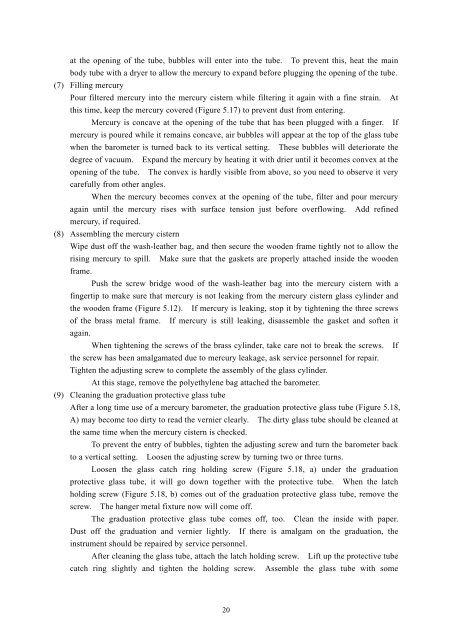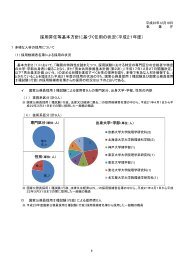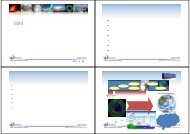Chapter 5 Measurement of Atmospheric Pressure
Chapter 5 Measurement of Atmospheric Pressure
Chapter 5 Measurement of Atmospheric Pressure
Create successful ePaper yourself
Turn your PDF publications into a flip-book with our unique Google optimized e-Paper software.
at the opening <strong>of</strong> the tube, bubbles will enter into the tube. To prevent this, heat the mainbody tube with a dryer to allow the mercury to expand before plugging the opening <strong>of</strong> the tube.(7) Filling mercuryPour filtered mercury into the mercury cistern while filtering it again with a fine strain. Atthis time, keep the mercury covered (Figure 5.17) to prevent dust from entering.Mercury is concave at the opening <strong>of</strong> the tube that has been plugged with a finger. Ifmercury is poured while it remains concave, air bubbles will appear at the top <strong>of</strong> the glass tubewhen the barometer is turned back to its vertical setting. These bubbles will deteriorate thedegree <strong>of</strong> vacuum. Expand the mercury by heating it with drier until it becomes convex at theopening <strong>of</strong> the tube. The convex is hardly visible from above, so you need to observe it verycarefully from other angles.When the mercury becomes convex at the opening <strong>of</strong> the tube, filter and pour mercuryagain until the mercury rises with surface tension just before overflowing. Add refinedmercury, if required.(8) Assembling the mercury cisternWipe dust <strong>of</strong>f the wash-leather bag, and then secure the wooden frame tightly not to allow therising mercury to spill. Make sure that the gaskets are properly attached inside the woodenframe.Push the screw bridge wood <strong>of</strong> the wash-leather bag into the mercury cistern with afingertip to make sure that mercury is not leaking from the mercury cistern glass cylinder andthe wooden frame (Figure 5.12). If mercury is leaking, stop it by tightening the three screws<strong>of</strong> the brass metal frame. If mercury is still leaking, disassemble the gasket and s<strong>of</strong>ten itagain.When tightening the screws <strong>of</strong> the brass cylinder, take care not to break the screws. Ifthe screw has been amalgamated due to mercury leakage, ask service personnel for repair.Tighten the adjusting screw to complete the assembly <strong>of</strong> the glass cylinder.At this stage, remove the polyethylene bag attached the barometer.(9) Cleaning the graduation protective glass tubeAfter a long time use <strong>of</strong> a mercury barometer, the graduation protective glass tube (Figure 5.18,A) may become too dirty to read the vernier clearly. The dirty glass tube should be cleaned atthe same time when the mercury cistern is checked.To prevent the entry <strong>of</strong> bubbles, tighten the adjusting screw and turn the barometer backto a vertical setting. Loosen the adjusting screw by turning two or three turns.Loosen the glass catch ring holding screw (Figure 5.18, a) under the graduationprotective glass tube, it will go down together with the protective tube. When the latchholding screw (Figure 5.18, b) comes out <strong>of</strong> the graduation protective glass tube, remove thescrew. The hanger metal fixture now will come <strong>of</strong>f.The graduation protective glass tube comes <strong>of</strong>f, too. Clean the inside with paper.Dust <strong>of</strong>f the graduation and vernier lightly. If there is amalgam on the graduation, theinstrument should be repaired by service personnel.After cleaning the glass tube, attach the latch holding screw. Lift up the protective tubecatch ring slightly and tighten the holding screw. Assemble the glass tube with some20






![関東地方の「紅葉の見ごろ予想」[PDF形式:250KB] - 気象庁](https://img.yumpu.com/47747063/1/184x260/pdf250kb-.jpg?quality=85)

![雨に関する各市町村の50年に一度の値一覧[PDF形式:417KB] - 気象庁](https://img.yumpu.com/47450161/1/190x134/50pdf417kb-.jpg?quality=85)
![1か月予報[九州北部地方]解説資料](https://img.yumpu.com/47153516/1/184x260/1.jpg?quality=85)
![職員募集案内パンフレット[PDF形式:約9MB] - 気象庁](https://img.yumpu.com/45714300/1/184x260/pdf9mb-.jpg?quality=85)


![ダウンロードファイル[PDF形式: 約15MB] - 気象庁](https://img.yumpu.com/43657928/1/190x135/pdf-15mb-.jpg?quality=85)


